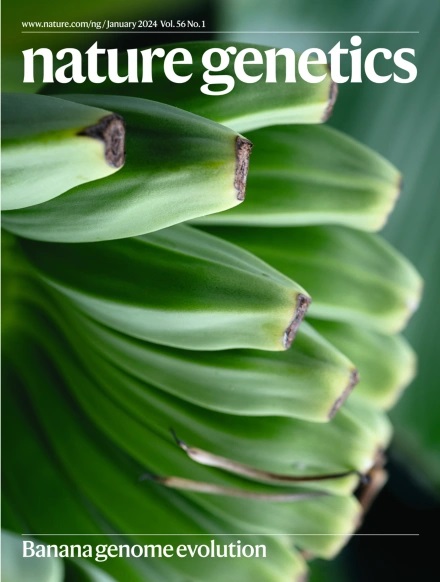棉花的端粒到端粒基因组组装提供了对着丝粒进化和短季节适应的见解
IF 31.7
1区 生物学
Q1 GENETICS & HEREDITY
引用次数: 0
摘要
棉花(Gossypium hirsutum L.)是一种具有重要经济意义的重要异源多倍体作物。在这里,我们展示了精英品种中棉113的端粒-端粒组装。利用PacBio HiFi、Oxford Nanopore Technology (ONT)超长读测序和Hi-C等技术,我们的基因组序列在连续性和完整性上超越了以往的基因组,解析了26个着丝粒区和52个端粒区、5S rDNA簇和核仁组织区。在G. hirsutum特有的D08染色体上发现了一个系统发育新近的着丝粒重新定位,涉及一个祖先着丝粒的失活和一个独特的、基于卫星重复的着丝粒的形成。基因组分析评估了关键农艺性状的有利等位基因聚集,并发现了一个早熟单倍型,该单倍型来自于一个11mb的周中心反转,该反转是在毛毛草驯化早期进化而来的。我们的研究揭示了短季节适应的基因组起源,可能涉及原始驯化形式的反转渗入,随后是现代育种计划中的单倍型分化。本文章由计算机程序翻译,如有差异,请以英文原文为准。


A telomere-to-telomere genome assembly of cotton provides insights into centromere evolution and short-season adaptation
Cotton (Gossypium hirsutum L.) is a key allopolyploid crop with global economic importance. Here we present a telomere-to-telomere assembly of the elite variety Zhongmian 113. Leveraging technologies including PacBio HiFi, Oxford Nanopore Technology (ONT) ultralong-read sequencing and Hi-C, our assembly surpasses previous genomes in contiguity and completeness, resolving 26 centromeric and 52 telomeric regions, 5S rDNA clusters and nucleolar organizer regions. A phylogenetically recent centromere repositioning on chromosome D08 was discovered specific to G. hirsutum, involving deactivation of an ancestral centromere and the formation of a unique, satellite repeat-based centromere. Genomic analyses evaluated favorable allele aggregation for key agronomic traits and uncovered an early-maturing haplotype derived from an 11 Mb pericentric inversion that evolved early during G. hirsutum domestication. Our study sheds light on the genomic origins of short-season adaptation, potentially involving introgression of an inversion from primitively domesticated forms, followed by subsequent haplotype differentiation in modern breeding programs. A telomere-to-telomere genome assembly of the elite Gossypium hirsutum variety ZM113 provides insights into upland cotton short-season adaptation and identifies a repositioned, satellite repeat-rich centromere.
求助全文
通过发布文献求助,成功后即可免费获取论文全文。
去求助
来源期刊

Nature genetics
生物-遗传学
CiteScore
43.00
自引率
2.60%
发文量
241
审稿时长
3 months
期刊介绍:
Nature Genetics publishes the very highest quality research in genetics. It encompasses genetic and functional genomic studies on human and plant traits and on other model organisms. Current emphasis is on the genetic basis for common and complex diseases and on the functional mechanism, architecture and evolution of gene networks, studied by experimental perturbation.
Integrative genetic topics comprise, but are not limited to:
-Genes in the pathology of human disease
-Molecular analysis of simple and complex genetic traits
-Cancer genetics
-Agricultural genomics
-Developmental genetics
-Regulatory variation in gene expression
-Strategies and technologies for extracting function from genomic data
-Pharmacological genomics
-Genome evolution
 求助内容:
求助内容: 应助结果提醒方式:
应助结果提醒方式:


